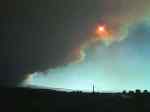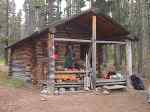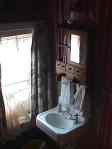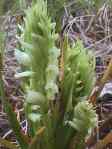While waiting to find out from Yellowstone, we rearrange our plans. We spend two weeks mopping up other plots in Wyoming, closer to roads.
I feel weird about having an injury nobody else can see. When Bill rolled a sharp rock and slashed his leg, the hospital where they stitched it up thought it looked like a knife wound. When Crow woke up one morning so sick we took him to the E.R. in Rawlins, at least he was throwing up and feverish (best conclusion, much later, was a spider bite). My own condition, the only sign is my own complaints; and I hate to complain.
Everywhere we go, people see our Forest Service green rig and ask if we’re up there fighting fires. The blazes are in full force, the bad fire season predicted by the warm and dry spring. The smoke near Thermopolis is so thick it darkens the sky and colors the sun sunset red at midday.
“No,” we explain, “We’re the one part of the Forest Service that doesn’t fight fires.” In fact, our work, forest inventory, is even higher priority than firefighting. One guy asks how to get a firefighter job.
At one time, maybe I thought firefighting was romantic. If I hadn’t already changed my mind, Bill’s talk would’ve convinced me.
“You’re working out on the line, digging in the dirt. Chopping. You’re filthy. You don’t get enough rest. Maybe grab a few hours in your sleeping bag in the ditch. And along the line you got this military type guy all the time yelling at you, ‘Faster! Faster!'”
I think I could handle that, but I’d have a problem with it so boring. The same mindless motion all day.
Now, it’s the weekend before the Lamar Valley. We’re in Cody. We’ve been through Cody three or four times already this summer. It’s a nice town, a good size. Big enough to have things, but small enough it’s not crazy.
All I knew about Cody before staying here was Buffalo Bill. Colonel Cody founded this place around 100 years ago, and still lives on in spirit. The spirit is that you come here to have fun. He had his Wild West show, and Cody continues the same tradition. The town is touristy, and strategically placed east of Yellowstone, about as close as you can find reliable weather. It’s the nearest real town that direction.
Cody has a lot of attractions, for a place that could pass as a little snippet of the Midwest at first glance. There’s rafting on the Shoshone River, right past the bluffs below the neighborhoods. There’s a huge Buffalo Bill Western museum, and a Native American arts center. Our first stay of the summer, they were having a powwow, with flocks of costumed Indian dancers. Cody has a Frontier Town, fairly well done, amidst all the tacky motels at the west edge. There’s sharpshooters, and outlaw reenactments, and fly fishing. And, every night, a rodeo.
The rodeo clown tells lame jokes. Well, he’s probably got a lot of good mileage out of them. “Hey, that there’s a teenage horse.” He pauses for effect. “Wants to stay out all night!” The broncos, after dumping their riders, frequently have high energy and run around and around the ring. Hard to corral them back into the stables. The clown serves the purpose, among others, of keeping the crowd amused while this housekeeping is tended to.
The riders are mostly young, teens and twenties. The announcer gives some rodeo history. These skills grew out of ranch work in the old west, and finally codified into competition. I’m impressed with the calf roping. I would be challenged to even stay on a horse at gallop, let alone throw a rope while doing it, and at a moving target. It’s amazing most of them even get close.
Some of the buckers are what they call “come apart” horses. Like, it was a good working horse for a time, then “…just up and come apart,” started bucking, and couldn’t be ridden any more. And so had a future in rodeo.
I learned something else about the bucking broncos and bulls this summer that changed my picture of it all. Animal rights activists are complaining rodeo is cruel. The system responds with information, Sunday supplement articles and the like, on how the animals are kindly managed. The bulls and horses spend their time, when not on the circuit, in quiet pastures, by winding rivers, beneath shady trees. They are treated well. The business is in the hands of one or a few families who never sell their livestock, in the interest, they say, of maintaining standards high. These animals are bred, for generations, to buck; and are only rented out to do it. At the rodeo, each run from of the chute lasts mere seconds. These mounts only have to “work” a total of perhaps an hour or so in their entire lives. Humane? Certainly!
They should all be shot! What’s the use of a horse you can’t get any work out of? A weird world we live in, that trafficking in these particularly useless steeds is big, and highly profitable business! Well, whatever!
The young riders come from all over. Florida. Virginia. Some from local Meeteetse. I get the impression few of them are ranch kids. But I admire their dedication. It takes a lot to get all the equipment, to practice, and take their chances on being maimed for life.
Years ago, I met a young guy who rode rodeo. The business of his family was well-drilling in Klickitat County, Washington. His mom, he said, wouldn’t let him ride until he could put up his own money for insurance. If that’s typical, these guys have an expensive hobby! That on top of, in each rodeo, having to pay to compete. Sure there’s prize money, but it can’t be a living.
We’re in Cody the weekend before the Lamar Valley. My foot feels pretty good, but I figure I better test it. I get my full pack and go hike a few hours down by the river. The results are bad. Back at the room, my foot feels the same as when I first tweaked it. It’s decision time.
This doesn’t really hurt, but it feels wrong inside. I can trek, but what if it gets bad up in the woods? If I need to bail, someone would have to hike out with me. And that means both, because one alone would not be safe, nor able to get the job done by remaining.
I drive myself down to the ER. I need an outside opinion. I make it clear, at the desk, this is not a pressing trauma. Any others can go ahead of me, and I brought plenty to read.
The emergency room scene is colorful, as always. There are a couple of bikers, and their friends, in for a motorcycle crash. Not too serious. The victim is in good spirits, regaling everyone with jokes. Half the summer, all of Wyoming has been crawling with hawgs, overflow I guess, from Sturgis 2000. They’re considerate, and well received, but inevitably someone must have a mishap.
I finally figured out what I like about the biker scene, aside from how some of the guys look. It’s not a “family” trip! I got nothing against families, but it gets cloying sometimes, that everything has to be family this and family that. The Christian Right organizations have given “family” an especially sour tang in my mouth, using it as an excuse for anti-gay oppression. So here’s thousands of folks, a lot of het couples included, and not a dydee in the batch! Let’s hear it for diversity. Maybe they’ve got kids at home, or in the works, but thank the Goddess they aren’t flaunting it!
There are others in the ER. I talk awhile to a young guy, Sean, in from a NOLS course. He’d had a urinary tract infection, not quite serious enough for an evac. But then another young woman had slipped in a boulder field and hit her face on a rock. So they brought her out, and he was having his problem seen to also. She is there, and I steel myself knowing facial cuts tend to bleed and look more horrible than they really are.
The NOLS kids were in the Absoroka Range, the same formation as up the Lamar. Sean tells me the old volcanoes, of which the lofty Absorkas are the mere roots, are speculated at having been 45,000 feet tall; over eight miles, higher than any mountains on earth today.
Finally, it’s my turn. X-ray shows nothing; no dislocation or stress fracture. Deep point tenderness is inconclusive. Dr. Rand’s advice is much like my own; stay off it awhile. As I expected, the decision is up to me. But I wanted a medical opinion.
So, no Lamar Valley. It’s a tough choice but I figure if I do right, there may be other summers of field work to come. Since I’m going to miss this trip, it looms large in my imagination. The woods become the fairest and most charming ever to be seen, with overarching trees and mossy glades. Fascinating formations of the petrified wood must surely jut out at every turn. I can almost taste the purple of the amethyst crystals, sparkling everywhere, big as my thumb!
We got word from Yellowstone it’s OK for a backcountry party of two. So it’s time for goodbyes. Bill and Henry drive off west and I pack up. I ship most of the gear out from Mailboxes, Etc. just around the corner, and hop on the bus. A lot of the route home is replays of roads I know from the summer’s travel.
Between Cody and Greybull is an agricultural region called the Emblem Bench. Out in the alfalfa fields, there are all these white boxes. About the size of a refrigerator on its side, they’re spaced every acre or so. On some farms, they are rude plywood, in others neat corrugated metal mini-sheds. Some fields have them identified by large block numbers, 100, 114, etc. In others, they’re painted in unique colorful patterns; orange sunbursts on this one, blue triangles on that, green chevrons on the other. Obviously, work goes into this. Keeping track of where you are in the alfalfa is somehow important. Something goes in those boxes, but what? Irrigation equipment? Frost protection? Gopher traps? Mystery.
Around Thermopolis, I see lines of green rigs pulled off on roads across the valley. Farther south fires are burning in the Wind River Canyon, in easy view. They’re across the river from the highway, fortunately. Still, it’s impressive. Orange flames hunker like live things in brushy hollows. One brown grassy meadow, a facet of the canyonside, the fire is marching across it right now. The burning line travels in a deliberate front, sending up a lazy sheet of smoke. The turf it’s passed is black.
Across the vast peniplain, east from Shoshoni to Casper, night slowly falls. We come abreast of thunderstorms, flashing over the mountains to south and north. It rains, and the road is wet. Through the drop-spattered windows, something glows, an orange smear in the sagebrush night, a mile or more to the left.
“Is that a fire?” the little Indian boy in the seat behind me asks.
“That’s all I can think it could be.”
On layover in Casper, I’m glad I always waterproof my pack. It’s raining hard and luggage gets drenched in a moment, curbside. Lightning strikes, and the TV in the bus station keeps going off. Shortly, it comes on again, but a different channel. Everything in Wyoming has to be built to take whatever nature can dish out.
Back on the road, the driver is headed through the night city to the freeway. A small sign propped at the top of the onramp announces “FREEWAY CLOSED”. Police cars parked with lights atwinkle guarantee nobody makes the mistake.
“Flooded,” someone mutters, and sure enough a gray lake replaces the lanes of I-25 for a hundred yards, the surface a tracery of small wavelets in the orangy sodium vapor streetlighting. I remember this dip. We stayed near here just last week, in hundred plus temperatures, on our way to the Shirley Mountains. I happened to walk along this very way going to get dinner. That sudden lake there could be six feet deep in the middle.
“I don’t know Casper,” apologizes the driver, starting to turn right, at random, seeking another route.
“Left, left,” says another passenger and me. We direct the driver to the other highway, out of town, back to the freeway, and on.





